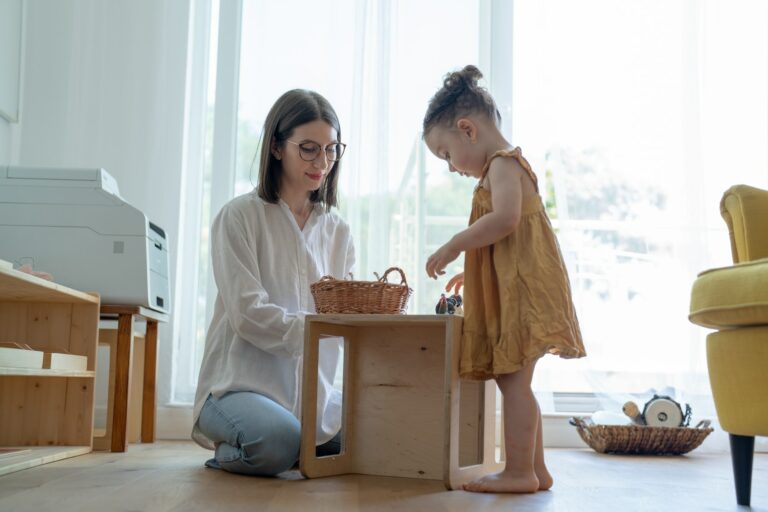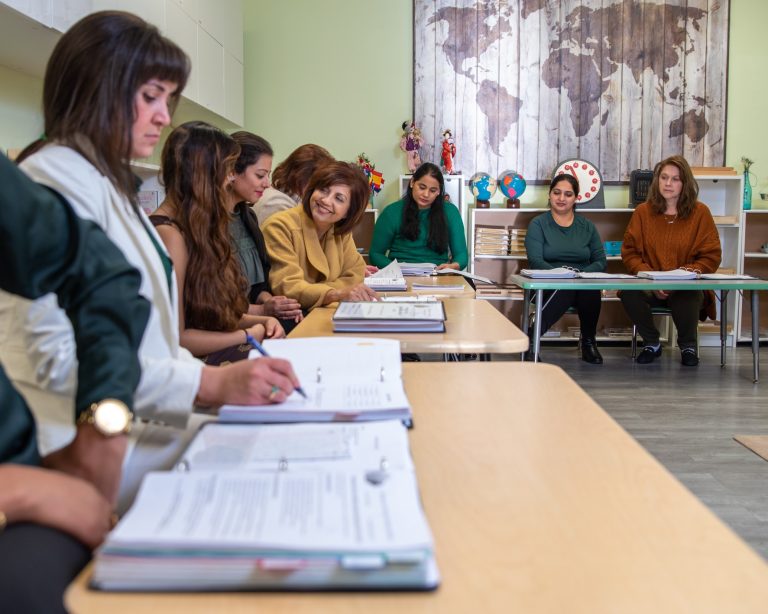5 Tips for Classroom Management in Montessori Schools
When observing a Montessori classroom as part of your Montessori training, you might be impressed. Young children sit quietly, concentrating intently on various activities throughout the classroom. No teacher is going around telling the students to be quiet or assigning them tasks. Instead, the children freely pick activities from the shelves and clean up when finished. The children are engaged and seem to be enjoying themselves!
How does this happen? It seems like magic! Yet, it’s not. It’s all because of the Montessori classroom management and a unique approach to discipline. Here are five tips that can help budding Montessori teachers and parents foster a calm and productive atmosphere:
Montessori Classroom Management: A Different Approach
Montessori classroom management is very different than in traditional classrooms. As Montessori said in a series of lectures called Maria Montessori Speaks to Parents, “Those who say it is our duty to keep the child in blind obedience, that we have a right to correct, and that in consequence the child will become intelligent, good, and instructed, are deceiving themselves.”
In other words, traditional discipline doesn’t work! Teaching children to “do as you’re told” doesn’t result in long-term success. This discipline discourages free thinking. It also breeds anger and dislike of everyday tasks like cleaning up after oneself.
Instead, Montessori classroom management aims to help children see the benefit of good behavior and hard work. Plus, it helps children become life-long learners. Most importantly, Montessori classroom management meets each student’s needs and helps them grow to their full potential. Here are 5 tips about Montessori classroom management to help you as a parent or new teacher:
1. The Prepared Environment Is Classroom Management
Montessori classrooms are beautiful. Each shelf contains many exciting and engaging activities. Children can’t wait to take items off the shelves and learn!
Boredom is the cause of many behavior issues. When children are bored, they look for something to do. Sometimes, that means getting into mischief!
Yet, in the Montessori classroom, this isn’t an issue. New materials are always available. Teachers constantly evaluate what to add to the classroom to meet each child’s needs and interests.
Children are more likely to concentrate and be motivated to learn when there are interesting activities to enjoy. This is why Montessori emphasized providing a beautiful environment. Each material should be attractive and complete.
In The Secret of Childhood, Montessori wrote, “But in our specially prepared environments we see them all at once fix themselves upon some task, and then their excited fantasies and their restless movements disappear altogether; a calm, serene child, attached to reality, begins to work out his elevation through work. Normalisation has been achieved.”
In other words, behavior issues disappear when children are engaged in interesting work. Children’s eyes light up when teachers present students with experiments. They love getting the chance to care for the classroom plants. Paging through a picture book in an easy chair is a relaxing experience. These are just a few examples of fun, but educational activities that are available in many Montessori classrooms. Every day, children look forward to the many activities they’ll enjoy. That leaves no time for poor behavior.
2. Discipline Comes from Freedom
It seems impossible, but it’s true! When children are free to move around the classroom and choose their own work, they become disciplined. They are able to concentrate and focus. Why?
Freedom means that children are more interested in and dedicated to their work. Adults experience this, too. When you pick your work, aren’t you more passionate about it? For children, this is also true.
That doesn’t mean that Montessori classrooms don’t have any rules. Students of online Montessori training courses learn that there is one main classroom rule. The rule is to respect yourself, others, and the environment. That means children must allow others to work, and they are not allowed to distract others. They must also care for the classroom and the materials.
Yet, amazingly, children learn to do this over time. Eventually, Montessori teachers don’t have to intervene much at all! How does it happen? Children slowly become “normalized.” As a part of this process, they achieve the third level of obedience.
According to Montessori, there are three levels of obedience. At the first level, a young child can only obey when they’re being asked to do something they already want to do. For example, if a parent invites a toddler outside, they may agree, but only because they also want to go outside. When the parent says it’s time to go inside, the toddler fusses. At the second level of obedience, children can obey if they want to please the person asking them to do something. For example, an adult asks a toddler to put their jacket on. If the toddler likes the adult and wants to help them, they’ll put their jacket on. However, obedience at this level is also subject to change at a whim.
At the third level of obedience, everything changes. It is called “joyful obedience.” Now, children can see the benefit of what they’re being asked to do, so they do it! For example, if you ask a child to help clean up, a child in the third level of obedience will think, “If I clean up, the space will be clean and ready to use again.” So, they happily help clean up.
Montessori teachers understand the three levels of obedience and work toward all children achieving the third level of obedience. They do this by inviting children to participate in the classroom community. When they’ve seen enough other students and adults model responsible behavior, they eventually follow along.
Montessori said, “the Montessori teacher is constantly looking for a child who is not yet there.” In other words, Montessori teachers believe that each child will grow into a responsible, respectful, and important member of the community. It’s only a matter of time. With this perspective, the teacher recognizes that the child needs encouragement and guidance along the way.
3. Observe First
What does misbehavior look like? It might not be exactly what you think!
If the main rule is that children must respect each other and the classroom, many behaviors are acceptable. For example, a child can wander around the classroom observing others and thinking about what work to pick. As long as they don’t bother others, they can do so freely.
Montessori once said, “Respect all the reasonable forms of activity in which the child engages and try to understand them.” In other words, try to see what the child’s goal is. Observe what they’re doing and try to understand the “why” behind their behavior. A toddler who plays in a toilet may simply want to play with water! Or, a child running around the classroom might need some work that allows them to practice gross motor skills.
This Montessori classroom management tip encourages teachers and teachers in training to watch what a child is doing carefully. Observe before intervening. Then, if you do step in, you’ll know how to approach the situation.
4. Try Redirecting
One classroom management strategy, especially in the 3 to 6-year-old classroom, is redirection. What does redirection mean? It is an attempt to remind the child of the appropriate behavior. For example, if a child leaves a mess and doesn’t clean up their work, the teacher can remind them to clean up. Often, a Montessori teacher can motivate the student by saying something like, “I know you’re a very good cleaner because yesterday you cleaned up beautifully. Can you show me?” If necessary, the teacher can even help the child and say, “Come, let’s clean up together.”
Through redirection, children get a second chance. They get to do the right thing! Often, a simple reminder or an invitation to a new, exciting activity is enough to help children get back on track.
5. “Gluing” Can Help Students Refocus
For students who need more support, “gluing” is another tool. During “gluing,” the teacher keeps the child by their side for a short time. For example, the teacher might say, “Stay by my side and watch while I give this presentation. Then, we’ll find something to do together.” The child can benefit from watching another child concentrate, focus, and work on an activity. It might even inspire them to do the same! Then, the teacher can help the child find an engaging activity in the classroom.
When teachers notice that some students need lots of redirection and “gluing,” it may be because they’re new students and not used to the classroom. However, teachers also need to consider the prepared environment. Could the student need something that’s missing in the classroom? Perhaps they need more challenging work or work that stimulates their senses. Through observation, teachers can discover what each child needs and help meet these needs.
Classroom Management in Your Online Montessori Training
Classroom management is an essential part of your online Montessori training. When seeking out an online Montessori training program, look for a program that goes beyond teaching you how to use the materials. You’ll need a training program that teaches you the principles of Montessori so you can foster a calm, productive, learning community.
Some classroom management techniques are best learned by observing a classroom. So, if there is a hybrid online Montessori training option available, it is worth your while! With a hybrid option, you’ll get to observe a real, in-person class and also practice teaching.
At Montessori Professional Training Canada, we offer several online Montessori training courses, including hybrid courses at our Calgary location. Join us and deepen your understanding of the Montessori method! Feel free to reach out with any questions. We would love to hear from you!







